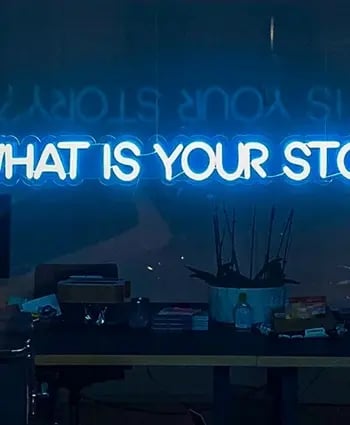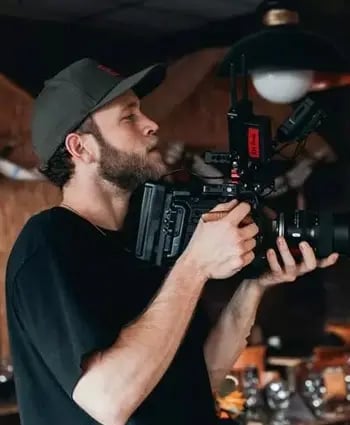7 Video Marketing Trends 2022
Discover how video marketing is changing in 2022, with an overview of the latest trends.
Today, Video is the ultimate way to provide entertaining and educational content while helping you make a deeper connection with your audience.
In fact, videos about a product or service help 90% of online shoppers make a purchase decision and 64% of consumers are more likely to buy a product after watching a video about it.
You just have to go on any of your social media apps to see that video has completely taken over our feeds. But what are the latest trends in video marketing for 2022?
So what are the latest trends we're seeing in video marketing?
- User-Generated content
- Behind-The-Scenes video content
- Accessible Creative
- Video SEO
- Live Streaming
- Short-form and long-form videos
- Connected TV Ads
1. User-Generated Content (UGC)
User Generated Content is on the up and up, and is a great way to build trust in your brand alongside your more branded video campaigns.
To add to this, TikTok sees the buying process as an infinite loop, not a marketing funnel. In other words, the buyer journey doesn't "end" with a purchase, it loops back on itself, with users posting about their purchase, offering feedback on products, and spreading awareness on their own profiles.
Following a purchase, one in four TikTok users has made a post about their new product, and one in five has made a tutorial video.
2. Behind-The-Scenes video content
We're a nosy lot, us humans. And our collective fascination with real people doing real stuff shows that.
This comes from a desire for authenticity in the brands we buy from, as well as the resurgence of DIY and crafting we all turned to throughout the pandemic. We seem to love watching people as they go about their daily lives and pursue their hobbies.
Offering a window into your brand's life, pursuits, and challenges through behind-the-scenes content gives viewers that AAA pass to your brand.
Formats such as outtakes, bloopers and extra footage that didn't make the final cut are a great way to give your viewers that peek behind the curtain.
3. Accessible creative
Accessibility in video is thankfully becoming more of a talking point recently, and rather than being a current "trend" per se, will constantly evolve and improve.
Accessibility in video marketing adds vital elements to your media so that anyone can easily engage with your content, whether or not they have a disability. Think: transcriptions, thoughtful colour-use, and audio descriptions.
An example of video accessibility is captioning in videos, which works both for those who need captions due to a disability, as well as for those who choose to watch videos silently as they scroll.
4. Video SEO
You may already know how to optimise your website pages for SEO like a pro, but how much do you know about optimising your video content for search?
Optimizing your video for search engines isn't anything new, but it's now starting to become a mainstream practice to ensure that video content can be easily found.
Here are some tips on how to do that.
5. Live streaming
Demand for live video content isn't going away after the pandemic, it's actually growing.
And while we seem to prefer video content in general, we engage at a much higher rate when the content is live.
For example, Facebook users watch live videos for 3x longer than pre-recorded videos, and live content generates 6x more interactions.
Another staggering 2022 statistic is that 71 million hours of content is viewed every day on live-streaming platform, Twitch, which began as a video game streaming service but has since expanded to appeal to a broader audience with more of a variety of live-streaming content.
6. A combination of Short-form & long-form videos
Shortly after TikTok's success with short-form content, YouTube rolled out Shorts, Instagram released Reels, and almost every other social platform now has a "stories" feature that allows you to upload short videos. But even though short videos are popular, that doesn't mean long-form content is dead.
Motioncue's survey found that for Millennials, YouTube is still the number one platform for watching video content. Plus, TikTok has just introduced 10-minute videos.
These lend themselves well to vlogs, video podcasts, tutorial videos, interviews and more. And whatever TikTok does, you can bet the other social media platforms will follow.
7. Connected TV ads
At the tail end of 2021, Forbes named CTV the fastest growing video advertising platform. Netflix, Hulu, HBO Max, Disney Plus, and Amazon Prime are all examples of platforms that people subscribe to on their CTV devices, allowing viewers to watch what they want, whenever they want on their Apple TVs, Amazon Fire sticks, Playstations etc.
And because these platforms are constantly capturing data and gathering audience insights in order to improve their algorithms for their viewers, they're pretty much a marketer's dream.
With this data, you can reach small, highly-targeted audiences with specifically personalized content as they make their way through a TV series. This means you can serve up highly targeted sequential ads that push viewers further down the marketing funnel.

Written by Emily Malone Marketing Manager for Venture — a full-service video production agency that specialises in producing creative videos & campaigns that get real results.




